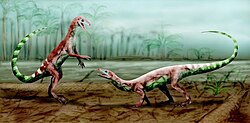Malerisaurus
| Malerisaurus Temporal range: Late Triassic,
| |
|---|---|

| |
| Malerisaurus robinsonae | |
| Scientific classification | |
| Domain: | Eukaryota |
| Kingdom: | Animalia |
| Phylum: | Chordata |
| Class: | Reptilia |
| Clade: | Archosauromorpha |
| Clade: | †Allokotosauria |
| Family: | †Azendohsauridae |
| Subfamily: | †Malerisaurinae |
| Genus: | †Malerisaurus Chatterjee, 1980 |
| Species | |
Malerisaurus is an extinct genus of archosauromorph known from Telangana of India and Texas of the USA.[1][2]
Description
[edit]Malerisaurus was a medium-sized archosauromorph which averaged 1.2 meters in length.[3] Malerisaurus is known from the holotype ISIR 150, two articulated and almost complete skeletons which were discovered as the presumable gastric contents of two skeletons of Parasuchus hislopi. It was collected from the Lower Maleri Formation, dating to the late Carnian or early Norian stage of the Late Triassic. Malerisaurus robinsonae was a small archosauromorph, probably capable of climbing trees and swimming. The skull has some adaptations to a carnivorous diet, but is nevertheless unspecialised and probably more of an insectivore. Malerisaurus, seen as a diapsid skull, shows primitive and advanced facies in its unossified laterosphenoid, absence of antorbital and mandibular fenestrae, gracile form, primitive girdles, elongated cervicals and absence of dermal armour. Chatterjee (1980) assigned it to the suborder Prolacertiformes, which currently represents four families: Sharovipterygidae, Protorosauridae, Prolacertidae and Tanystropheidae. Chatterjee provisionally regarded Malerisaurus as close to Protorosaurus.[1]
A second species, M. langstoni, is known from the holotype TMM 31099-11, a partial but poorly preserved skeleton. It was collected in the Otis Chalk Quarry 2 (TMM 31099 locality) from the Colorado City Formation, Chinle Group, dating to the early Carnian stage of the Late Triassic, about 228–227.5 million years ago. It was found in the Howard County of Texas.[2] Spielmann et al. (2006) redescribed the type material of M. langstoni and concluded that it's indistinguishable from the type species of Trilophosaurus, T. buettneri, and thus M. langstoni represents its junior synonym.[4]
Nesbitt et al. (2017) reinterpreted Malerisaurus as an allokotosaurian archosauromorph belonging to the family Azendohsauridae.[5] In 2021, Nesbitt et al. once again looked at Malerisaurus, and found it to be an early-diverging, but late surviving, carnivorous azendohsaurid. This study also found M. langstoni to be a valid and distinct species of Malerisaurus.[6]
Etymology
[edit]Malerisaurus was named by Sankar Chatterjee in 1980 and the type species is Malerisaurus robinsonae named in honour of the British Paleontologist who worked in India, Pamela Lamplugh Robinson.[1] A second species, M. langstoni, was named by him in 1986.[2] The generic name is derived from the name of the Lower Maleri Formation, where the holotype of the type species was collected, and sauros, Greek for "lizard".[1] The specific name of M. langstoni honors the American paleontologist and professor Wann Langston, Jr.[2]
Classification
[edit]In their 2024 review of Malerisaurus, Sengupta, Ezcurra & Bandyopadhyay analyzed its phylogenetic placement within Azendohsauridae. They recovered Malerisaurus langstoni as the sister taxon to Puercosuchus, with this clade in turn sister to Malerisaurus robinsonae, together forming the clade Malerisaurinae. Their results are displayed in the cladogram below:[7]
| Allokotosauria |
| ||||||||||||||||||||||||
References
[edit]- ^ a b c d Sankar Chatterjee (1980). "Malerisaurus, A New Eosuchian Reptile from the Late Triassic of India". Philosophical Transactions of the Royal Society of London, Series B. 291 (1048): 163–200. Bibcode:1980RSPTB.291..163C. doi:10.1098/rstb.1980.0131.
- ^ a b c d Sankar Chatterjee (1986). "Malerisaurus langstoni, a new diapsid reptile from the Triassic of Texas". Journal of Vertebrate Paleontology. 6 (4): 297–312. doi:10.1080/02724634.1986.10011627.
- ^ "Palaeos Mesozoic: Triassic: Late Triassic: Carnian - 2". Archived from the original on 2013-12-24. Retrieved 2012-05-25.
- ^ Spielmann, J.A., Lucas, S.G., Hunt, A.P., and Heckert. 2006. Reinterpretation of the holotype of Malerisaurus langstoni, a diapsid reptile from the Upper Triassic Chinle Group of West Texas. The Triassic-Jurassic Terrestrial Transition. New Mexico Museum of Natural History and Science, Bulletin 37:543-547.
- ^ Sterling J. Nesbitt; Michelle R. Stocker; Martín Ezcurra; Nicholas C. Fraser; Andrew B. Heckert; Adam Marsh; William Parker; Bill Mueller; Adam C. Pritchard (2017). "The 'strange reptiles' of the Triassic: the morphology, ecology, and taxonomic diversity of the clade Allokotosauria illuminated by the discovery of an early diverging member". Society of Vertebrate Paleontology 77th Annual Meeting Program & Abstracts: 168–169.
- ^ Nesbitt, Sterling J.; Stocker, Michelle R.; Ezcurra, Martín D.; Fraser, Nicholas C.; Heckert, Andrew B.; Parker, William G.; Mueller, Bill; Sengupta, Saradee; Bandyopadhyay, Saswati; Pritchard, Adam C.; Marsh, Adam D. (2021). "Widespread azendohsaurids (Archosauromorpha, Allokotosauria) from the Late Triassic of western USA and India". Papers in Palaeontology. 8. doi:10.1002/spp2.1413. ISSN 2056-2802. S2CID 245049571.
- ^ Sengupta, Saradee; Ezcurra, Martín D.; Bandyopadhyay, Saswati (2024-01-26). "The redescription of Malerisaurus robinsonae (Archosauromorpha: Allokotosauria) from the Upper Triassic lower Maleri Formation, Pranhita‐Godavari Basin, India". The Anatomical Record. doi:10.1002/ar.25392. ISSN 1932-8486.

